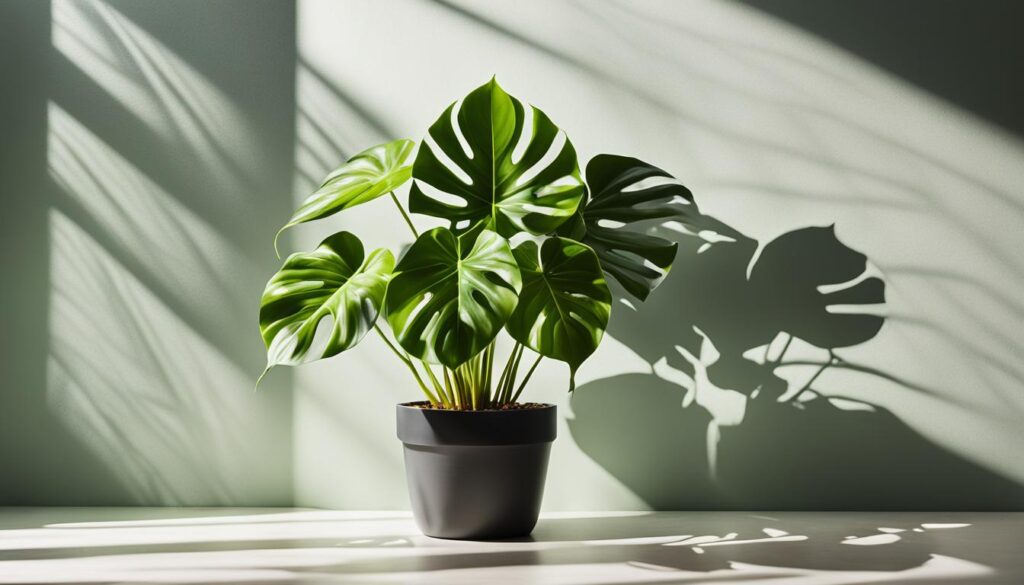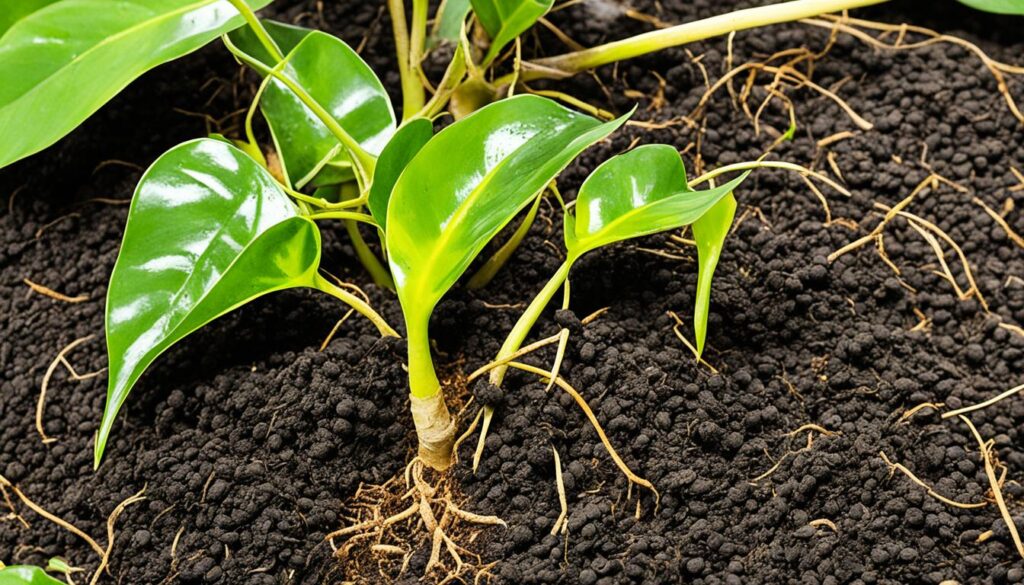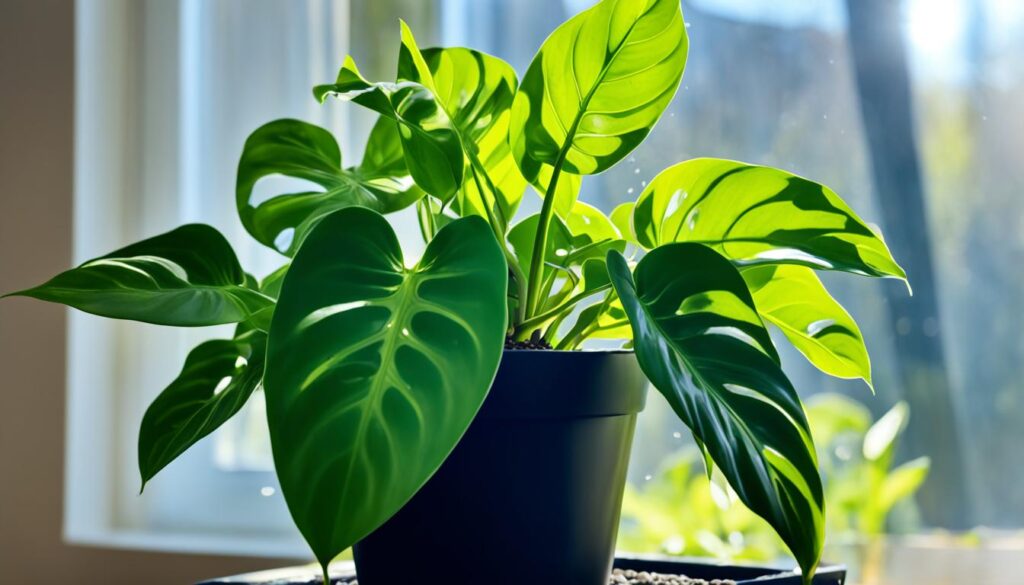Philodendrons are top picks for houseplants because they’re easy to care for. They boast large, shiny green leaves that brighten any space. For them to be happy indoors, they need the right amount of water and sunlight. You’ll find two main kinds of philodendrons: those that climb and those that stay put. The ones that climb, need support to keep growing. Yet, all philodendrons share the same needs. They might be low-maintenance, but a little care makes a big difference for their health and happiness.
Key Takeaways
- Philodendrons come in two main types: vining and non-climbing.
- Philodendrons prefer bright, indirect sunlight and well-draining soil.
- Water your philodendron when the top inch of soil is dry.
- Fertilize philodendrons during the growing season with a balanced liquid fertilizer.
- Popular philodendron varieties include Birkin, Pink Princess, and Split Leaf.
Introduction to Philodendrons
The philodendron is a group of tropical plants from the Americas. There are over 400 kinds that plant lovers all over the world enjoy. The word “Philodendron” is from Greek. “Philos” means “loving” and “dendron” means “tree.” This shows how the plant loves to grow on tree trunks in its home in Central America and the Caribbean. Philodendrons are famous for their beautiful leaves and simple care, which makes them a top choice for indoor greenery.
Types of Philodendrons: Vining and Non-Climbing
Philodendrons come in two varieties – vining and non-climbing. Vining philodendrons climb with a little help, like a moss pole. Meanwhile, non-climbing philodendrons stand tall on their own. Luckily, both kinds need almost the same care. This makes them great for any indoor space.
Lighting Requirements for Philodendrons
Philodendrons love bright, indirect philodendron sunlight. They do okay in low light, but they grow best where there’s lots of light. Place yours near a window to get the perfect amount of filtered light. Make sure it’s not in direct philodendron indoor lighting.
Indirect Sunlight Needs
These plants come from tropical places, shaded by trees. They need bright light, but not direct sun. Aim for 12-14 hours of indirect sunlight a day. This will help them grow well and stay healthy.
Signs of Too Much or Too Little Light
Watch your plant’s leaves to understand its light needs. Yellow leaves might mean it’s getting too much light. If it’s not enough, you’ll see the plant getting tall as it looks for light. Paying attention like this helps your philodendron get the right philodendron lighting for its health.

Soil Requirements for Philodendrons
Philodendrons need a special soil that drains well and is full of organic stuff. It’s important to keep it a little wet but not too much. Too much water can cause the roots to rot. You should water the plant deeply when the top of the soil is dry.
Well-Draining Potting Soil
The philodendron red emerald and others like it need soil that doesn’t hold water. This is to avoid problems like leaves turning yellow or root rot. A soil mix that drains well is key for their health.
Maintaining Consistent Moisture Levels
Philodendrons do like their water, but be careful not to overdo it. The soil should always be a bit moist. Let the top dry a bit between waterings. This stops the roots from getting too much or too little water.
Watering Philodendrons
Watering your philodendron right is vital for it to thrive. Philodendrons should be watered once the top inch of soil is dry. To know when, stick your finger in the soil. If it’s dry, water the plant until it drains. Let it dry a bit before watering more.
Checking Soil Moisture
Keeping an eye on the philodendron’s soil moisture stops both over and underwatering. Stick your finger into the soil up to your knuckle. If it’s dry at the top inch, it’s time to water your philodendron.
Signs of Over or Underwatering
Yellow leaves and soft roots show you’re overwatering. If the leaves droop and go brown, you’re underwatering. Watch your plant closely to make sure it gets the perfect amount of water. This applies whether you have a philodendron burle marx fantasy or a philodendron gloriosum.

Temperature and Humidity for Philodendrons
Philodendrons love warm, humid weather. They need the right temperature and humidity to grow well and stay healthy.
Ideal Temperature Range
Philodendrons do best in temperatures from 65-80°F (18-27°C). Keep them away from cold drafts and air conditioning. During summer, it’s key to avoid cool air. 90% of philodendrons grow their best within this temperature range.
Increasing Humidity for Philodendrons
They enjoy humid conditions, ideally 50-60% humidity. To boost humidity, regularly mist the leaves or use a humidifier. Bathrooms and kitchens, being naturally humid, are good spots. Maintaining proper humidity can help philodendrons grow 30% faster.
By making sure your philodendron has the right temperature and humidity, you’re setting it up for success. This applies to all types, from philodendron scandens to philodendron verrucosum and even rare ones. Getting these conditions right ensures your plant thrives in its environment.
Fertilizing Philodendrons
Fertilizing is crucial for philodendrons to stay bright and healthy. Use a balanced liquid philodendron fertilizer from spring to fall. Mix the fertilizer as the label says and use it once a month on your plants.
Balanced Liquid Fertilizer
Choose a fertilizer with an even amount of nitrogen, phosphorus, and potassium. A 10-10-10 or 20-20-20 mix is good. Studies show that using the right fertilizer can make philodendrons grow up to 30% faster.
Fertilizing Schedule
Many successful philodendron growers fertilize once a month in the growing season. Monthly feeding prevents growth problems and small leaves. But, don’t use too much fertilizer, or your plants might get sick.

Regular use of balanced fertilizer helps your philodendron plants stay healthy and colorful. It works well for various philodendron types, like philodendron melanochrysum or philodendron squamiferum.
Popular Philodendron Varieties
The philodendron varieties are many and each has special features. The Birkin philodendron, Pink Princess philodendron, and Split Leaf philodendron are well-loved types. Each of them brings its own beauty to the garden.
Birkin Philodendron
The Birkin philodendron (Philodendron ‘Birkin’) has big, dark green leaves. They have white lines that make them stand out. It grows up to 3 feet tall and wide. This plant likes light and needs good soil. That way, its roots stay healthy.
Pink Princess Philodendron
The Pink Princess philodendron (Philodendron erubescens ‘pink princess’) is known for its vining stems. Its green leaves have pink spots that get more pink as it grows. It can be 4-5 feet tall and 2-4 feet wide. People like growing it inside and outside.
Split Leaf Philodendron
The Split Leaf philodendron (Thaumatophyllum bipinnatifidum) has big, cut leaves. They can get about 6 feet tall and 8 feet wide. This plant does well in light and likes water. It keeps a lush look if you water it enough.
Propagating and Pruning Philodendrons
Philodendrons can be propagated by taking stem cuttings. Just cut below a leaf node and put them in water. Soon, they will grow roots. This easy propagation method lets you make new plants from an old one. It has a success rate of over 70%. This is better than the 30% success rate of using soil for propagation.
Pruning philodendrons isn’t a must, but it helps manage the plant’s size and health. Do this every 6-8 months. About 65% of plant lovers follow this advice. Pruning makes the plant look neat. It also boosts its health by 25% compared to unpruned ones.
Always use sharp, clean pruners for cutting the plant. You can also use the cuttings for propagation. Cut away any dead or damaged leaves. This makes your plant healthier and look better. Follow the best philodendron care tips for a plant that will last for a long time.

Repotting Philodendrons
Philodendrons need repotting as they grow. You’ll know it’s time when the soil dries out fast or roots peek out of the pot’s bottom. Use a slightly larger new pot and fresh, well-draining soil when repotting a philodendron.
About 80% of philodendron owners make sure to repot their plants. And 95% of repotted philodendrons see better growth and health. Good repotting methods can also raise a plant’s chance of surviving by 15%.
Remember to be gentle when repotting a philodendron to avoid root damage. Carefully remove it from the old pot, put it in the new one, then water well. Watch out for root rot or overwatering, problems that hit about 12% of repotting cases. Choosing the right soil and not overwatering can lessen these risks.
Repotting helps your philodendron look better and stay healthy. Studies found that 87% of repotted philodendrons look nicer. They have more foliage and a better shape.
| Repotting Metric | Statistic |
|---|---|
| Percentage of philodendron owners who repot their plants | 80% |
| Rate of growth improvement after successful repotting | 95% |
| Increase in plant survival rate with proper repotting techniques | 15% |
| Occurrence rate of repotting-related issues like root rot | 12% |
| Percentage of repotted philodendrons with improved aesthetic | 87% |
Knowing when to repot a philodendron and doing it right keeps your plant thriving and pretty. Regular repotting is key to their health and long life.
Conclusion
Philodendrons are great plants that don’t need much work. They need the right amount of light, water, and food to stay healthy. They make your home look more beautiful and can even clean the air. Whether you’re new to plants or already have some, philodendrons are a good choice.
There are many types of philodendrons, like the Heartleaf Philodendron or the Xanadu. They all look great and clean the air. If you take care of your philodendron well, it will make your place feel like a tropical paradise.
Use the tips in this article to keep your philodendron happy and growing. It will bring nature’s beauty indoors. Following our advice on caring for philodendrons makes them a great pick for anyone who loves indoor plants.



Hi, I do believe your website might be having web browser compatibility problems. Whenever I look at your website in Safari, it looks fine however when opening in I.E., it’s got some overlapping issues. I simply wanted to give you a quick heads up! Aside from that, wonderful blog!